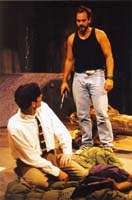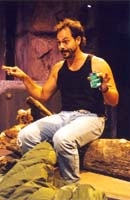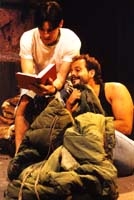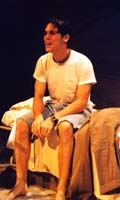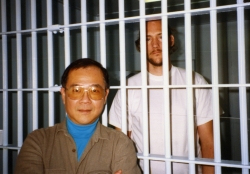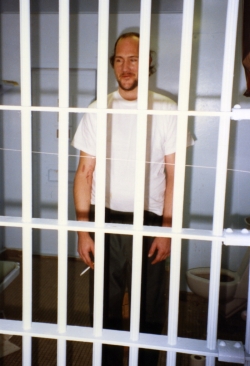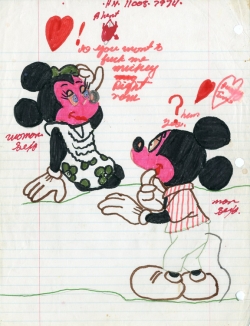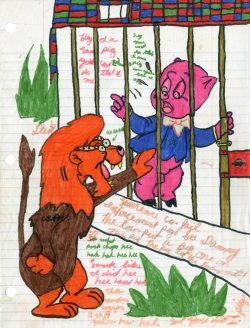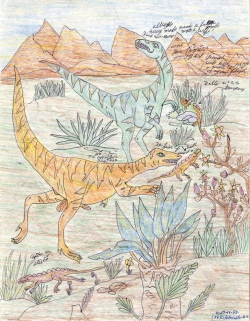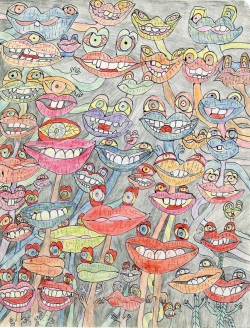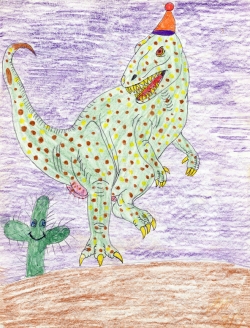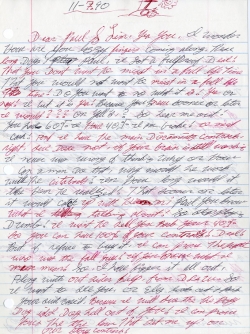Report to the River: A One-Act Play
Images from the Show
Overview
Requirements: 2M
Setting: Nick’s dormroom, a small carpetted central area containing a bed, a table and chair. Surrounding the dormroom is Jake’s campsite near the turnpike by the Kaw River in Lawrence, Kansas. Morning, Bastille Day (July 14), mid-1990s.
Plot: Nick, a student attending summer classes at the University of Kansas, introduces us to the facts and mysterious circumstances surrounding the disappearance of a nine-year-old boy along the Kaw River in his hometown of Lawrence, Kansas nearly ten years ago. Nick’s mother was a teacher in an elementary school briefly attended by the boy and, through his mother, Nick learns about how the boy had been befriended by 27-year-old transient from Texas, and how the two used to go fishing together along the river in the depressed and dilapidated low-income section of the city. After the boy’s dismembered boy is found along the banks of the river, the transient is charged with murder.
But all the evidence is purely circumstantial, and things are further complicated by the fact that the transient himsel has the mental age of a nine-year-old child. During the trial, the transient changes his story and, Rashomon-like, presents four different versions of how the boy died. Nick is absolutely obsesssed with this case and, in his mind’s eye, he becomes the boy in the flashback sequences showing us the relationship between the boy and the transient. By the time the play ends, we learn that it’s possible Nick might not have been a reliable narrator for the events which we have just witnessed.
Theme: How well do we know the underbelly of the towns and cities that we live in, the bridges which daily transport us but which really do not connect the comfortable middle-class with the less-fortunate and the homeless among us?
Notes: Like Nick in the play, I was fascinated by the newspaper accounts of the death of a nine-year-old boy in Lawrence; and how John William, a 27-year-old transient from Texas who had been living underneath the turnpike bridge, was apprehended and charged with the child’s murder. What first caught my attention was the report that the homeless man himself had the I.Q. of a nine-year-old child, and that he had built a raft which he meant to float down the river all the way to St. Louis, taking his own Huck Finn along for the journey.
Later, when I learned that this particular homeless person had been befriended by the boy’s family, but that the boy’s mother eventually threw the man out of their house for some unknown reason, days before the family’s Fourth of July cookout, and that the boy’s murder happened shortly afterwards, I was hooked. There was no turning back. I had to write the play.
I attended all the court hearings, bought over $2000 worth of court transcripts, and had over 16 hours of taped interviews with John William at the Douglas County Jail. I even had a lawyer draw up a contract between myself and John William, giving me universal rights to his story. Sherry Pigg, a reporter for The Topeka State-Capitol Journal, wrote a front-page story about this legal transaction, and it caused a furor not just in Topeka and Lawrence, but also in Kansas City. Under the Bundy Law, legal proceedings were brought against me, but I was eventually cleared of all charges. However, under the Victim’s Reparation Act, John William had to turn over to the Settlemyer family what little remaining cash I had given him for the rights to his story.
And then, in another article about the play I intended to write based on the case, Sherry Pigg accused me of exploiting and “profitting” by a child’s murder. I began to get anonymous death threats in the mail and on the telephone. The Lawrence police gave me tips on how to protect myself–e.g., walk my dog at different times of the day; take different routes when driving to work; park in different places in town and on campus; and, most frightening of all, not to sit in front of open windows and doorways inside my own house, especially at night, because anyone could walk into my backyard and take a shot at me. As a result of all this, I put my voluminous research away and did not write the play until the spring of 1997.
History: My original intention was to write a full-length courtroom drama based on the case, using a dozen actors, including someone who can play the nine-year-old victim. When I finished the first draft of the play, I sent it to my good friend Paul Hough in Kansas City. He had directed many of my earlier plays, and I wanted him to direct this one as well. Paul called me within days, said he had read it, said he had loved it, but that there was no way he could or would direct it. He told me no parent would ever allow their child to be in such a play, that the rehearsal process would be much too damaging to a child’s mental well-being, and that he could not in good conscience ever subject a child-actor to such a dangerous theatrical process. This shook me to the core and, in the summer of 1997, I quickly rewrote the play.
And that’s how Report to the River got turned into a one-act play with just two characters. It was produced by English Alternative Theatre at the Lawrence Arts Center, Oct. 9-12, 1997; and, yes, Paul Hough directed it with great passion and ingenuity. It was designed by Phill Schroeder, who also played the part of the transient. Michael Senften played the part of the college student who is obsessed with the case. The play was performed again on January 22, 1998 at the Region V festival of the Kennedy Center American College Theatre Festival held at the Johnson County Community College in Overland Park, KS. In June 1999, the play was given a staged reading (again with Schroeder and Senften as the two leads) and it won the top prize in playwriting at the Edward Albee Theatre Conference at Prince William Sound Community College in Valdez, Alaska. It had another staged reading at the ATHE pre-conference program at New York University, Tisch School of the Arts, New York City, July 29-Aug. 1, 2000.
Availability: From One Act Play Depot, and also from the author.



